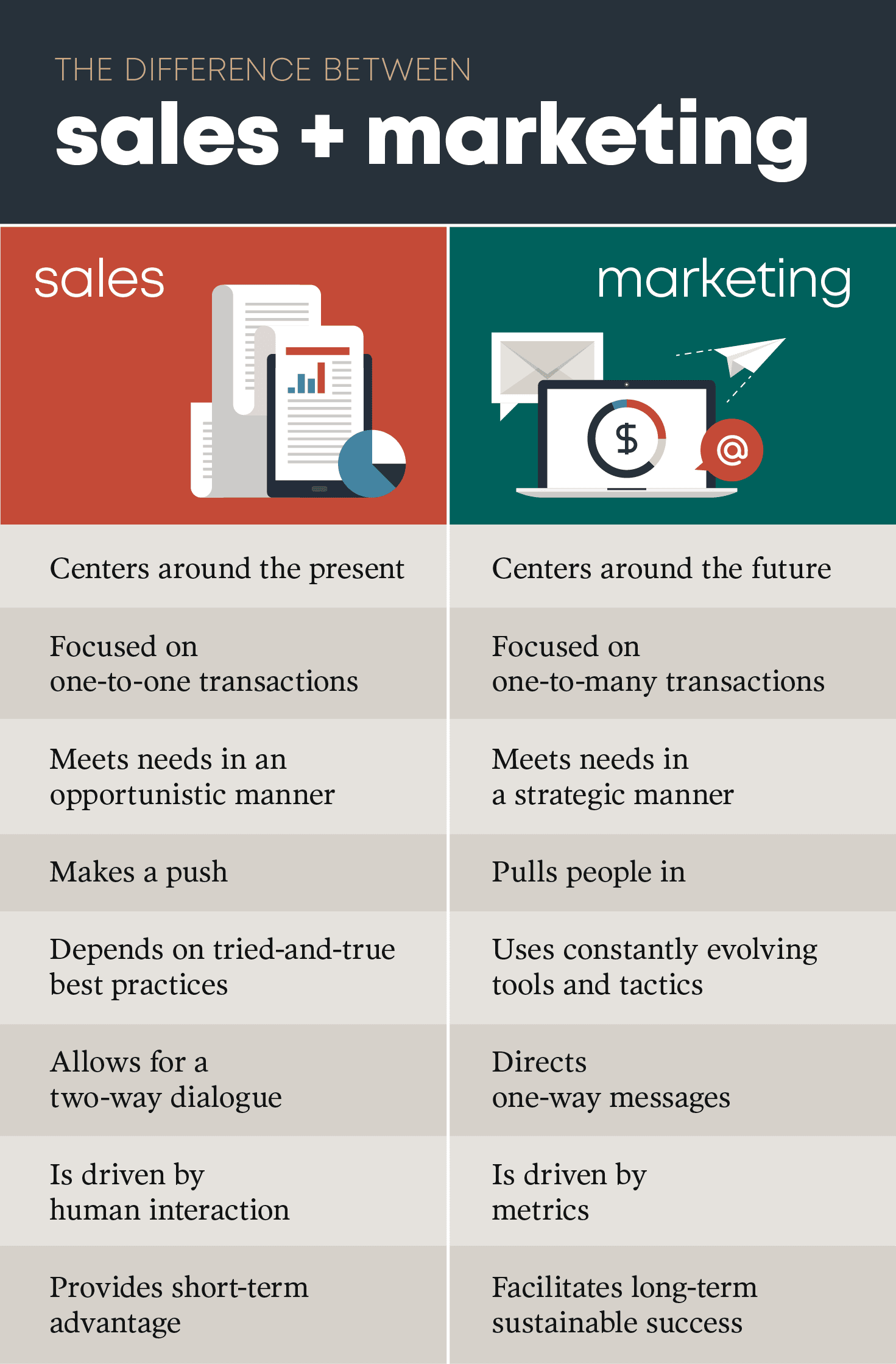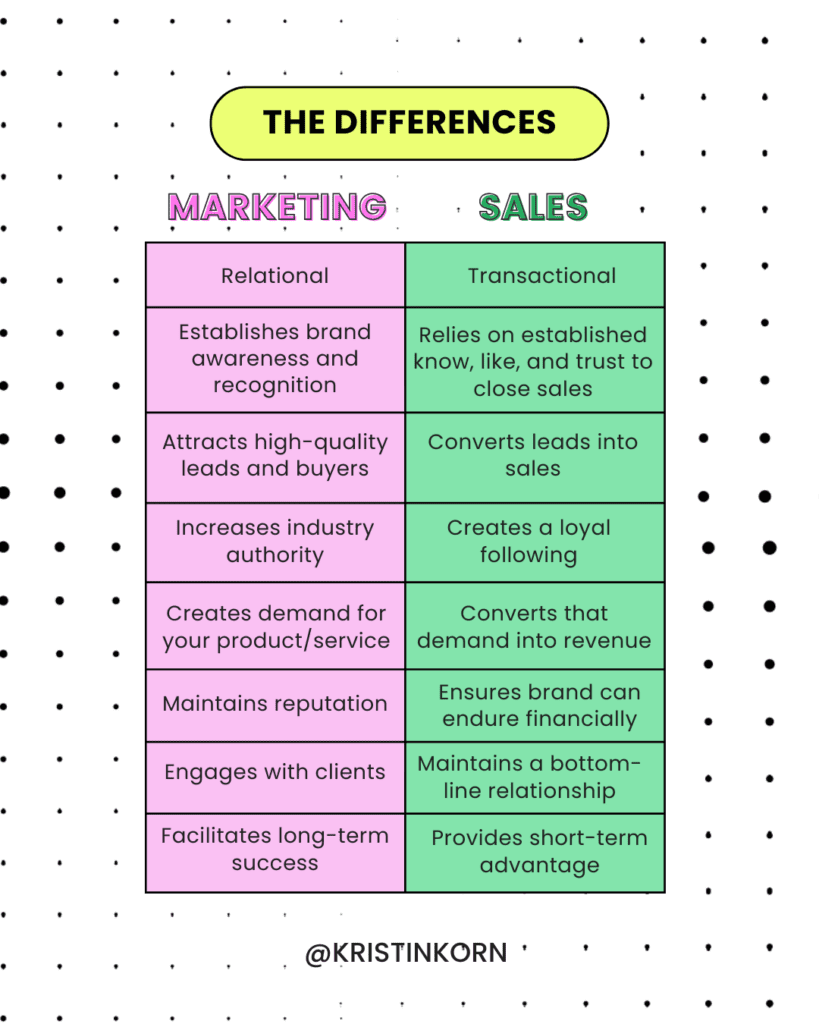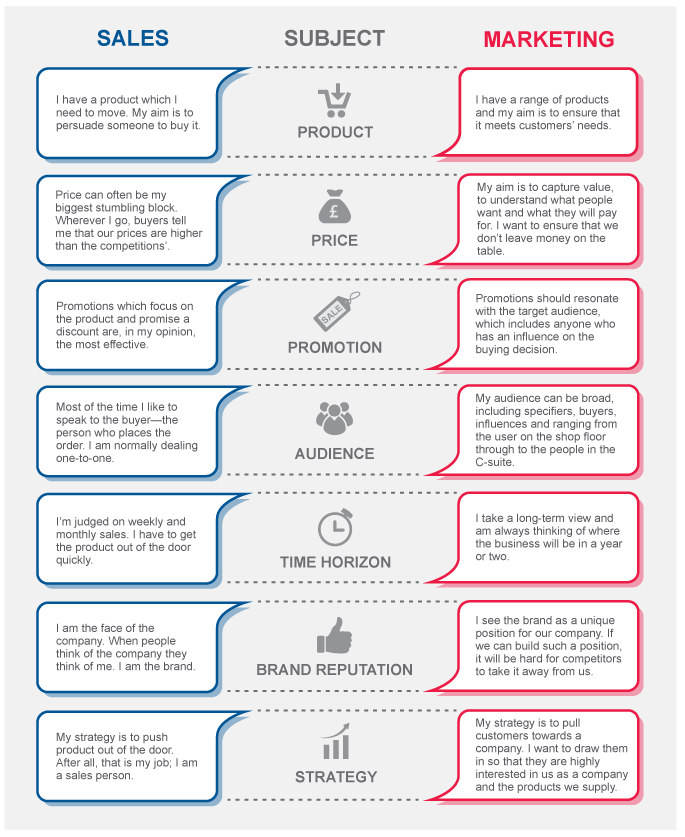Marketing and sales are two fundamental pillars of any business, often used interchangeably but serving distinct purposes. While both aim to drive revenue and foster customer relationships, their approaches and objectives differ significantly. Marketing focuses on creating awareness, generating interest, and building a brand’s reputation through strategic campaigns, content, and communication. Sales, on the other hand, is the direct process of converting leads into customers through personalized interactions and negotiations. Understanding the nuances between these two functions is crucial for businesses to align their strategies, optimize resources, and achieve sustainable growth in a competitive marketplace.
The Difference Between Marketing and Sales
Marketing and sales are two critical components of any business strategy, yet they serve distinct purposes and involve different processes. While both aim to drive revenue and grow the business, they focus on different stages of the customer journey. Marketing is about creating awareness and generating interest in a product or service, while sales focus on converting that interest into actual purchases. Understanding the difference between these two functions is essential for businesses to optimize their strategies and achieve their goals.
See Also How Different Is Customer Service Versus Marketing?
How Different Is Customer Service Versus Marketing?1. What is Marketing?
Marketing is the process of identifying, anticipating, and satisfying customer needs through the creation and promotion of products or services. It involves a wide range of activities, including market research, branding, advertising, content creation, and social media management. The primary goal of marketing is to attract potential customers and build a strong brand presence. Marketing strategies often focus on long-term relationships and customer engagement, aiming to create a loyal customer base over time.
2. What is Sales?
Sales, on the other hand, is the process of directly interacting with potential customers to persuade them to purchase a product or service. It involves activities such as lead generation, prospecting, negotiations, and closing deals. The primary goal of sales is to convert leads into paying customers. Sales teams often work closely with marketing to ensure that the leads generated are qualified and ready to make a purchase. Unlike marketing, which is more strategic and long-term, sales is often more tactical and focused on immediate results.
See Also What Does Product Marketing Actually Do? How Is It Different From Other Types of Marketing?
What Does Product Marketing Actually Do? How Is It Different From Other Types of Marketing?3. Key Differences Between Marketing and Sales
The main difference between marketing and sales lies in their focus and approach. Marketing is about creating demand and building brand awareness, while sales is about fulfilling that demand by converting leads into customers. Marketing strategies are often broad and aim to reach a wide audience, whereas sales strategies are more targeted and personalized. Additionally, marketing typically involves a longer time frame, as it focuses on building relationships and trust, while sales is more immediate, aiming to close deals quickly.
4. How Marketing and Sales Work Together
While marketing and sales have different roles, they are most effective when they work together. Marketing generates leads and nurtures them through the sales funnel, while sales teams take those leads and convert them into customers. Effective communication and collaboration between the two departments are crucial for success. For example, marketing can provide sales teams with valuable insights about customer behavior and preferences, while sales can offer feedback on what strategies are working and what needs improvement.
See Also Who Are/Is the Best Marketer/Advertiser of All Time and Why?
Who Are/Is the Best Marketer/Advertiser of All Time and Why?5. The Importance of Aligning Marketing and Sales
Aligning marketing and sales is essential for maximizing efficiency and achieving business goals. When these two functions are aligned, they can create a seamless customer journey, from initial awareness to final purchase. This alignment ensures that marketing efforts are generating high-quality leads that are more likely to convert, and that sales teams are equipped with the tools and information they need to close deals effectively. Misalignment between marketing and sales can lead to wasted resources, missed opportunities, and a disjointed customer experience.
| Aspect | Marketing | Sales |
|---|---|---|
| Focus | Creating demand and brand awareness | Converting leads into customers |
| Time Frame | Long-term | Short-term |
| Activities | Market research, branding, advertising | Lead generation, prospecting, closing deals |
| Goal | Build relationships and trust | Generate immediate revenue |
| Collaboration | Provides leads and insights | Converts leads and offers feedback |
What is the difference between sales and marketing roles?

 Best Search/Recruitment Firm for VP/Executive in Marketing?
Best Search/Recruitment Firm for VP/Executive in Marketing?Core Objectives of Sales and Marketing
The primary difference between sales and marketing lies in their core objectives. Marketing focuses on creating awareness, generating interest, and building a brand, while sales concentrate on converting leads into customers.
- Marketing aims to attract potential customers through campaigns, content, and strategies.
- Sales focuses on closing deals and achieving revenue targets.
- Marketing builds the pipeline, while sales ensures the pipeline converts into revenue.
Key Responsibilities in Sales vs. Marketing
The responsibilities in sales and marketing roles differ significantly. Marketing teams handle market research, branding, and lead generation, whereas sales teams manage direct customer interactions and negotiations.
See Also Convince me these aren't scams.
Convince me these aren't scams.- Marketing responsibilities include creating advertisements, managing social media, and analyzing market trends.
- Sales responsibilities involve prospecting, presenting products, and closing deals.
- Marketing nurtures leads, while sales converts them into paying customers.
Metrics and KPIs for Sales and Marketing
The metrics used to measure success in sales and marketing are distinct. Marketing focuses on engagement and reach, while sales emphasizes revenue and conversion rates.
- Marketing KPIs include website traffic, click-through rates, and lead generation numbers.
- Sales KPIs involve conversion rates, average deal size, and customer acquisition costs.
- Marketing tracks brand awareness, while sales monitors customer retention.
Collaboration Between Sales and Marketing Teams
Effective collaboration between sales and marketing is crucial for business success. Both teams must align their goals and strategies to ensure seamless operations.
- Marketing provides sales with qualified leads and customer insights.
- Sales offers feedback to marketing on lead quality and customer preferences.
- Both teams work together to refine messaging and improve customer experience.
Tools and Technologies Used in Sales and Marketing
The tools and technologies employed in sales and marketing differ based on their functions. Marketing relies on analytics and automation tools, while sales uses CRM systems and communication platforms.
- Marketing tools include email marketing software, SEO tools, and social media management platforms.
- Sales tools encompass CRM systems like Salesforce, sales tracking software, and communication tools like Zoom.
- Marketing focuses on data-driven strategies, while sales prioritizes relationship-building tools.
What is the difference between a sales person and a marketer?

Primary Focus and Objectives
The primary focus of a salesperson is to close deals and generate revenue by directly interacting with potential customers. In contrast, a marketer focuses on creating awareness, generating interest, and building a brand image to attract potential customers. The objectives of each role differ significantly:
- Salesperson: Aims to meet individual or team sales targets by converting leads into customers.
- Marketer: Works on long-term strategies to increase brand visibility and customer engagement.
- Salesperson: Focuses on immediate results and short-term goals.
- Marketer: Prioritizes building relationships and fostering customer loyalty over time.
Skill Sets and Expertise
The skill sets required for a salesperson and a marketer are distinct, as their roles demand different expertise. Here are the key differences:
- Salesperson: Requires strong interpersonal and negotiation skills to persuade customers.
- Marketer: Needs creativity and analytical skills to design campaigns and measure their effectiveness.
- Salesperson: Excels in one-on-one communication and relationship-building.
- Marketer: Focuses on mass communication and understanding market trends.
Tools and Strategies Used
The tools and strategies employed by a salesperson and a marketer vary based on their goals. Below are the key differences:
- Salesperson: Uses CRM tools, sales scripts, and direct outreach methods like cold calling.
- Marketer: Utilizes digital marketing tools, social media platforms, and content creation to reach a broader audience.
- Salesperson: Relies on personalized pitches and tailored solutions for individual customers.
- Marketer: Implements data-driven strategies to target specific demographics and segments.
Customer Interaction and Engagement
The level and type of customer interaction differ between a salesperson and a marketer. Here’s how:
- Salesperson: Engages directly with customers, often in real-time, to address their needs and close sales.
- Marketer: Interacts indirectly through campaigns, advertisements, and content to influence customer behavior.
- Salesperson: Builds personal relationships with clients to foster trust and loyalty.
- Marketer: Creates a brand persona that resonates with the target audience on a larger scale.
Metrics for Success
The metrics used to measure success for a salesperson and a marketer are different due to their distinct roles. Here’s a breakdown:
- Salesperson: Success is measured by the number of deals closed, revenue generated, and customer satisfaction.
- Marketer: Success is evaluated through metrics like brand awareness, lead generation, and campaign ROI.
- Salesperson: Focuses on individual performance and meeting quotas.
- Marketer: Tracks overall market impact and long-term growth.
Is there no real difference between marketing and sales?

What is the Core Purpose of Marketing?
Marketing focuses on creating awareness and generating interest in a product or service. Its primary goal is to attract potential customers and nurture them through the buyer's journey. Key activities include:
- Market research to understand customer needs and preferences.
- Branding to establish a recognizable identity.
- Content creation to educate and engage the audience.
What is the Core Purpose of Sales?
Sales, on the other hand, is about converting leads into paying customers. It involves direct interaction with potential buyers to close deals. Key activities include:
- Lead qualification to identify promising prospects.
- Negotiation to address objections and finalize terms.
- Closing deals to achieve revenue targets.
How Do Marketing and Sales Overlap?
While marketing and sales have distinct roles, they often overlap in practice. For example:
- Lead generation is a shared responsibility, with marketing attracting leads and sales qualifying them.
- Customer feedback from sales teams can inform marketing strategies.
- Collaborative tools like CRM systems help both teams work seamlessly.
What Are the Key Differences Between Marketing and Sales?
Despite their overlap, marketing and sales differ in several ways:
- Focus: Marketing focuses on long-term brand building, while sales focuses on short-term revenue generation.
- Approach: Marketing uses broad strategies like advertising, while sales uses personalized tactics like one-on-one meetings.
- Metrics: Marketing measures success through metrics like engagement rates, while sales tracks metrics like conversion rates.
Why is Alignment Between Marketing and Sales Crucial?
Alignment between marketing and sales ensures a cohesive customer experience and maximizes efficiency. Key benefits include:
- Improved lead quality due to shared goals and criteria.
- Faster sales cycles as marketing provides sales-ready leads.
- Higher revenue through coordinated efforts and reduced friction.
Is marketing higher than sales?

What is the Difference Between Marketing and Sales?
Marketing and sales are two distinct but interconnected functions within a business. Marketing focuses on creating awareness, generating interest, and building a brand, while sales is about converting that interest into revenue. Here are some key differences:
- Marketing involves strategies like advertising, content creation, and market research.
- Sales focuses on direct interactions with customers to close deals.
- Marketing aims to create demand, while sales fulfills that demand.
Is Marketing More Important Than Sales?
The importance of marketing versus sales depends on the business context. Both are essential, but their roles differ. Here’s why:
- Marketing builds the foundation by attracting potential customers.
- Sales ensures that the leads generated by marketing are converted into paying customers.
- Without marketing, sales teams would struggle to find qualified leads.
How Does Marketing Support Sales?
Marketing plays a crucial role in supporting sales efforts. It provides the tools and resources needed to make the sales process more effective. Key ways include:
- Creating brand awareness to make the sales pitch easier.
- Generating qualified leads through targeted campaigns.
- Providing sales enablement materials like brochures and case studies.
Can Marketing Exist Without Sales?
While marketing can exist independently, its ultimate goal is to drive sales. Here’s why marketing without sales may not be sustainable:
- Marketing efforts are measured by their impact on revenue generation.
- Without sales, marketing campaigns may not achieve their full potential.
- Both functions need to align to ensure business growth.
Which Generates More Revenue: Marketing or Sales?
Both marketing and sales contribute to revenue, but their roles are different. Here’s how they impact revenue generation:
- Marketing creates the initial interest and demand.
- Sales closes the deal and ensures customer satisfaction.
- Effective collaboration between the two maximizes revenue potential.
Frequently Asked Questions from Our Community
What is the primary difference between marketing and sales?
Marketing and sales are two distinct but interconnected functions within a business. Marketing focuses on creating awareness, generating interest, and building a brand through strategies like advertising, content creation, and market research. Its goal is to attract potential customers and nurture them through the buyer's journey. On the other hand, sales is the process of converting interested prospects into paying customers. It involves direct interaction with leads, understanding their needs, and closing deals. While marketing lays the groundwork, sales executes the final step of the transaction.
How do marketing and sales teams work together?
Marketing and sales teams must collaborate closely to achieve business success. The marketing team generates leads through campaigns, social media, and other channels, while the sales team follows up with these leads to close deals. Effective communication between the two ensures that the messaging is consistent and that the sales team has the necessary tools and information to convert leads. For example, marketing might provide sales with detailed customer personas or content to address specific pain points. This synergy ensures a seamless customer experience from initial awareness to final purchase.
Why is it important to differentiate between marketing and sales?
Understanding the difference between marketing and sales is crucial for optimizing business strategies. While marketing focuses on long-term brand building and lead generation, sales is about short-term revenue generation. By differentiating the two, businesses can allocate resources more effectively, set clear goals for each department, and measure performance accurately. For instance, marketing success might be measured by website traffic or social media engagement, while sales success is measured by conversion rates and revenue. This distinction helps avoid confusion and ensures both teams work toward their specific objectives.
Can a business succeed with only marketing or only sales?
A business cannot rely solely on either marketing or sales to succeed. Without marketing, a sales team would struggle to find qualified leads, resulting in wasted time and effort. Conversely, without a skilled sales team, even the most effective marketing campaigns may fail to convert leads into customers. Both functions are essential: marketing creates the demand, and sales fulfills it. For example, a company with excellent marketing but poor sales processes might attract many leads but fail to close deals, while a company with strong sales but weak marketing might struggle to generate enough leads to sustain growth.
Leave a Reply


Articles of interest